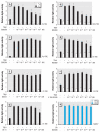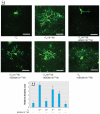Disruption of thyroid hormone receptor-mediated transcription and thyroid hormone-induced Purkinje cell dendrite arborization by polybrominated diphenyl ethers
- PMID: 20870570
- PMCID: PMC3040602
- DOI: 10.1289/ehp.1002065
Disruption of thyroid hormone receptor-mediated transcription and thyroid hormone-induced Purkinje cell dendrite arborization by polybrominated diphenyl ethers
Abstract
Background: Polybrominated diphenyl ethers (PBDEs) have been used as flame retardants and are becoming a ubiquitous environmental contaminant. Adverse effects in the developing brain are of great health concern.
Objective: We investigated the effect of PBDEs/hydroxylated PBDEs (OH-PBDEs) on thyroid hormone (TH) receptor (TR)-mediated transcription and on TH-induced dendrite arborization of cerebellar Purkinje cells.
Methods: We examined the effect of PBDEs/OH-PBDEs on TR action using a transient transfection-based reporter gene assay. TR-cofactor binding was studied by the mammalian two-hybrid assay, and TR-DNA [TH response element (TRE)] binding was examined by the liquid chemiluminescent DNA pull-down assay. Chimeric receptors generated from TR and glucocorticoid receptor (GR) were used to identify the functional domain of TR responsible for PBDE action. The change in dendrite arborization of the Purkinje cell in primary culture of newborn rat cerebellum was also examined.
Results: Several PBDE congeners suppressed TR-mediated transcription. The magnitude of suppression correlated with that of TR-TRE dissociation. PBDEs suppressed transcription of chimeric receptors containing the TR DNA binding domain (TR-DBD). We observed no such suppression with chimeras containing GR-DBD. In the cerebellar culture, PBDE significantly suppressed TH-induced Purkinje cell dendrite arborization.
Conclusions: Several PBDE congeners may disrupt the TH system by partial dissociation of TR from TRE acting through TR-DBD and, consequently, may disrupt normal brain development.
Figures






Comment in
-
Thyroid hormone understanding branches out: insights into PBDE impacts on brain development.Environ Health Perspect. 2011 Feb;119(2):A80-1. doi: 10.1289/ehp.119-a80a. Environ Health Perspect. 2011. PMID: 21285014 Free PMC article. No abstract available.
Similar articles
-
1,2,5,6,9,10-αHexabromocyclododecane (HBCD) impairs thyroid hormone-induced dendrite arborization of Purkinje cells and suppresses thyroid hormone receptor-mediated transcription.Cerebellum. 2011 Mar;10(1):22-31. doi: 10.1007/s12311-010-0218-1. Cerebellum. 2011. PMID: 20967578
-
Suppression of thyroid hormone receptor-mediated transcription and disruption of thyroid hormone-induced cerebellar morphogenesis by the polybrominated biphenyl mixture, BP-6.Neurotoxicology. 2011 Aug;32(4):400-9. doi: 10.1016/j.neuro.2011.02.008. Epub 2011 Mar 17. Neurotoxicology. 2011. PMID: 21396401
-
An in vitro method to study the effects of thyroid hormone-disrupting chemicals on neuronal development.Neurotoxicology. 2012 Aug;33(4):753-7. doi: 10.1016/j.neuro.2012.04.021. Epub 2012 May 9. Neurotoxicology. 2012. PMID: 22579998
-
Neurotoxicity of brominated flame retardants: (in)direct effects of parent and hydroxylated polybrominated diphenyl ethers on the (developing) nervous system.Environ Health Perspect. 2011 Jul;119(7):900-7. doi: 10.1289/ehp.1003035. Epub 2011 Feb 4. Environ Health Perspect. 2011. PMID: 21245014 Free PMC article. Review.
-
A mechanistic view of polybrominated diphenyl ether (PBDE) developmental neurotoxicity.Toxicol Lett. 2014 Oct 15;230(2):282-94. doi: 10.1016/j.toxlet.2013.11.011. Epub 2013 Nov 20. Toxicol Lett. 2014. PMID: 24270005 Free PMC article. Review.
Cited by
-
Toxic effects of decabromodiphenyl ether (BDE-209) on human embryonic kidney cells.Front Genet. 2014 May 6;5:118. doi: 10.3389/fgene.2014.00118. eCollection 2014. Front Genet. 2014. PMID: 24834073 Free PMC article.
-
Thyroid hormone related gene transcription in southern sand flathead (Platycephalus bassensis) is associated with environmental mercury and arsenic exposure.Ecotoxicology. 2017 Jul;26(5):600-612. doi: 10.1007/s10646-017-1793-4. Epub 2017 Mar 28. Ecotoxicology. 2017. PMID: 28353161
-
Association between maternal hypothyroidism and autism spectrum disorders in children.Pediatr Res. 2018 Mar;83(3):580-588. doi: 10.1038/pr.2017.308. Epub 2018 Jan 3. Pediatr Res. 2018. PMID: 29244797
-
Disruption of type 2 iodothyronine deiodinase activity in cultured human glial cells by polybrominated diphenyl ethers.Chem Res Toxicol. 2015 Jun 15;28(6):1265-74. doi: 10.1021/acs.chemrestox.5b00072. Epub 2015 Jun 2. Chem Res Toxicol. 2015. PMID: 26004626 Free PMC article.
-
Advanced morphological - behavioral test platform reveals neurodevelopmental defects in embryonic zebrafish exposed to comprehensive suite of halogenated and organophosphate flame retardants.Toxicol Sci. 2015 May;145(1):177-95. doi: 10.1093/toxsci/kfv044. Epub 2015 Feb 23. Toxicol Sci. 2015. PMID: 25711236 Free PMC article.
References
-
- Branchi I, Capone F, Alleva E, Costa LG. Polybrominated diphenyl ethers: neurobehavioral effects following developmental exposure. Neurotoxicology. 2003;24:449–462. - PubMed
-
- Carey M, Kakidani H, Leatherwood J, Mostashari F, Ptashne M. An amino-terminal fragment of GAL4 binds DNA as a dimer. J Mol Biol. 1989;209:423–432. - PubMed
Publication types
MeSH terms
Substances
LinkOut - more resources
Full Text Sources

